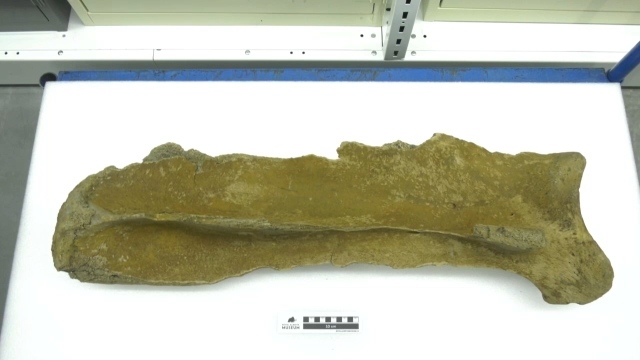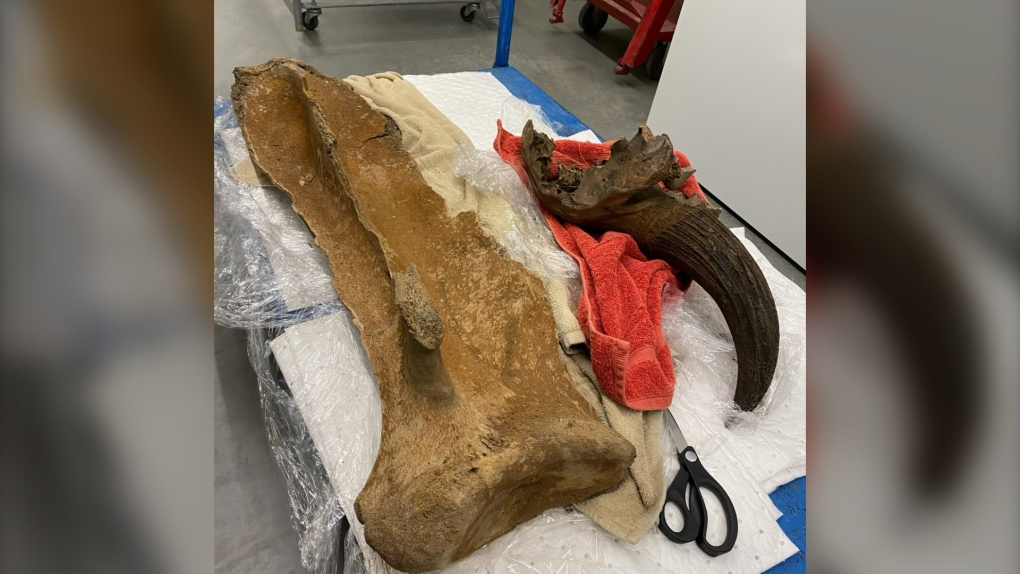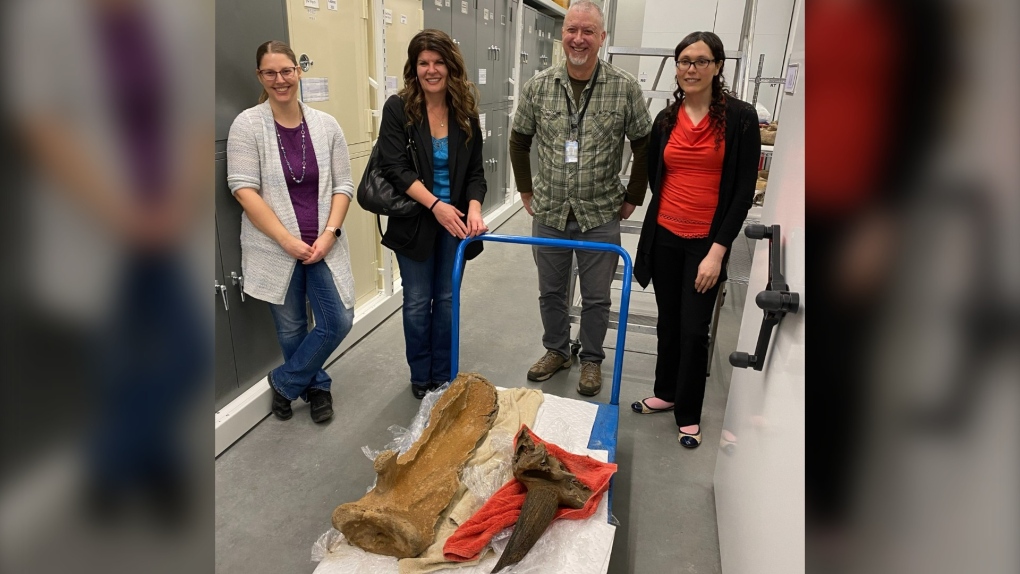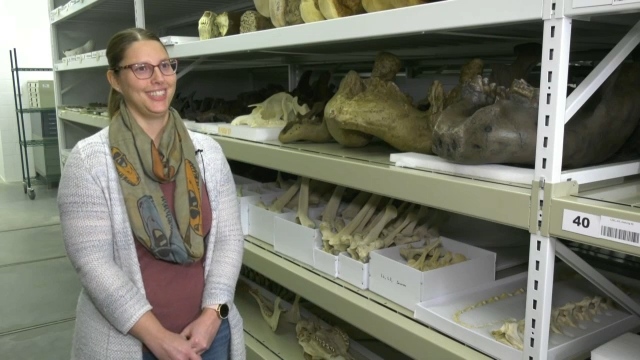Ice Age relic found by Alberta woman out walking her dogs
A chance discovery by an Edmonton area woman who was walking her dogs has turned out to be a massive fossilized bone that likely belonged to an Ice Age mammoth.
Stacy Long was walking out west of Devon last spring when she came across something jutting out of the river bank. That find has now been confirmed to be a fossil relic from the Ice Age, a potential scapula from an adult mammoth.
"On previous trips, there had been nothing," Long said. "This time, there was stuff coming out of the bank."
At first, she thought it was a large piece of wood. Long says she loves finding and collecting rocks for her garden.
"When I rinsed it off, it didn't look like wood anymore," she added. "So I thought, 'Oh, it might be something cool."
 A closeup of the shoulder blade Stacy Long found while walking her dogs west of Devon, Alta. (CTV News Edmonton/Darcy Seaton)
A closeup of the shoulder blade Stacy Long found while walking her dogs west of Devon, Alta. (CTV News Edmonton/Darcy Seaton)
She recalled how her husband was dubious at the time that she found anything exciting.
"I was a humanities teacher, not a science teacher," Long said. "He was just tired of me bringing rocks home for my flower bed."
"He was like, 'It's nothing,' but it ended up being something," she said with a laugh.
BUILDING THE PUZZLE OF ALBERTA'S HISTORY: RAM
She lugged the specimen home and sent a picture to the Royal Alberta Museum. After a series of emails, experts confirmed that Long had found a fossil that was just over a metre long. Long also came across a partial skull believed to be from a Bison antiquus from around the same era.
 The pair of fossils Stacy Long found while walking her dogs west of Devon last spring (Supplied).
The pair of fossils Stacy Long found while walking her dogs west of Devon last spring (Supplied).
Katherine Bramble, a RAM paleontologist, said the bone is believed to be a mammoth shoulder blade that is 10,000 to 14,000 years old. It has since been added to the museum's research and reference collection.
"We will be learning more about it from comparing it to other specimens, other mammoth bones, not just from her but elsewhere and that can tell us more about maybe what species it is," Bramble told CTV News Edmonton.
 Stacy Long (centre left) poses for a photo with Royal Alberta Museum staff, including paleontologist Katherine Bramble (far left) (Supplied).
Stacy Long (centre left) poses for a photo with Royal Alberta Museum staff, including paleontologist Katherine Bramble (far left) (Supplied).
What is now Alberta had two kinds of mammoths during the Ice Age, the larger but not as furry Columbian mammoth and the iconic woolly mammoth, Bramble explained.
Mastodons, which are more closely related to modern elephants, also lived in the area.
"It's too early to tell which species it could be," Bramble said.
For her, the find is exciting since mammoth and mastodon fossils are less common in Alberta when compared to dinosaur bones.
"What we have in the collections are teeth or tusk elements," she added. "We have a couple of arm or leg bones, but we don't have as much as we'd like to have."
Fossils, including the remains of plants and animals or traces of their activity, are protected in Alberta by the province's Historical Resources Act.
"By law, you are not allowed to dig for fossils if you find any," Bramble explained. "You need to have a permit for that."
"If you find something on the surface, you are allowed to collect it and take it home. Our preference would be that you get in contact with us and let us know what you found."
 Royal Alberta Museum paleontologist Katherine Bramble (CTV News Edmonton/Darcy Seaton).
Royal Alberta Museum paleontologist Katherine Bramble (CTV News Edmonton/Darcy Seaton).
Locating a different fossil like the one Long came across is helpful in building the puzzle of Alberta's natural history, Bramble said, like providing more details about where mammoths were living.
This spring, the museum plans to send a team to further probe the area where Long located the mammoth specimen in the hopes of finding more fossils.
"It just grows the story that we've been building over time about how Alberta looked in the Ice Age," Bramble said.
With files from CTV News Edmonton's Jeremy Thompson
CTVNews.ca Top Stories

opinion Tom Mulcair: Prime Minister Justin Trudeau's train wreck of a final act
In his latest column for CTVNews.ca, former NDP leader and political analyst Tom Mulcair puts a spotlight on the 'spectacular failure' of Prime Minister Justin Trudeau's final act on the political stage.
B.C. mayor gets calls from across Canada about 'crazy' plan to recruit doctors
A British Columbia community's "out-of-the-box" plan to ease its family doctor shortage by hiring physicians as city employees is sparking interest from across Canada, says Colwood Mayor Doug Kobayashi.
'There’s no support': Domestic abuse survivor shares difficulties leaving her relationship
An Edmonton woman who tried to flee an abusive relationship ended up back where she started in part due to a lack of shelter space.
opinion King Charles' Christmas: Who's in and who's out this year?
Christmas 2024 is set to be a Christmas like no other for the Royal Family, says royal commentator Afua Hagan. King Charles III has initiated the most important and significant transformation of royal Christmas celebrations in decades.
Baseball Hall of Famer Rickey Henderson dead at 65, reports say
Rickey Henderson, a Baseball Hall of Famer and Major League Baseball’s all-time stolen bases leader, is dead at 65, according to multiple reports.
Arizona third-grader saves choking friend
An Arizona third-grader is being recognized by his local fire department after saving a friend from choking.
Germans mourn the 5 killed and 200 injured in the apparent attack on a Christmas market
Germans on Saturday mourned the victims of an apparent attack in which authorities say a doctor drove into a busy outdoor Christmas market, killing five people, injuring 200 others and shaking the public’s sense of security at what would otherwise be a time of joy.
Blake Lively accuses 'It Ends With Us' director Justin Baldoni of harassment and smear campaign
Blake Lively has accused her 'It Ends With Us' director and co-star Justin Baldoni of sexual harassment on the set of the movie and a subsequent effort to “destroy' her reputation in a legal complaint.
Oysters distributed in B.C., Alberta, Ontario recalled for norovirus contamination
The Canadian Food Inspection Agency has issued a recall due to possible norovirus contamination of certain oysters distributed in British Columbia, Alberta and Ontario.


































